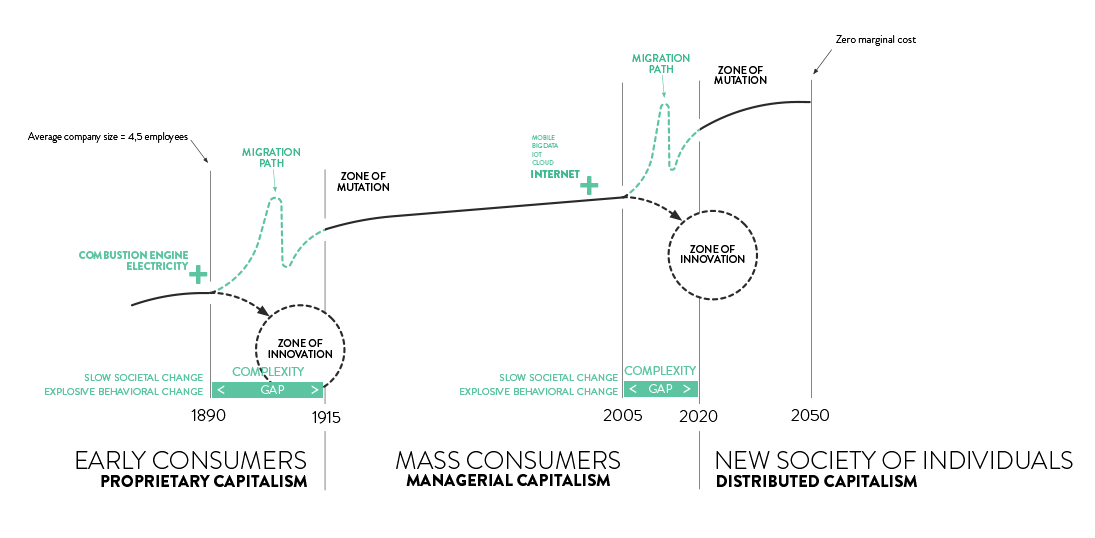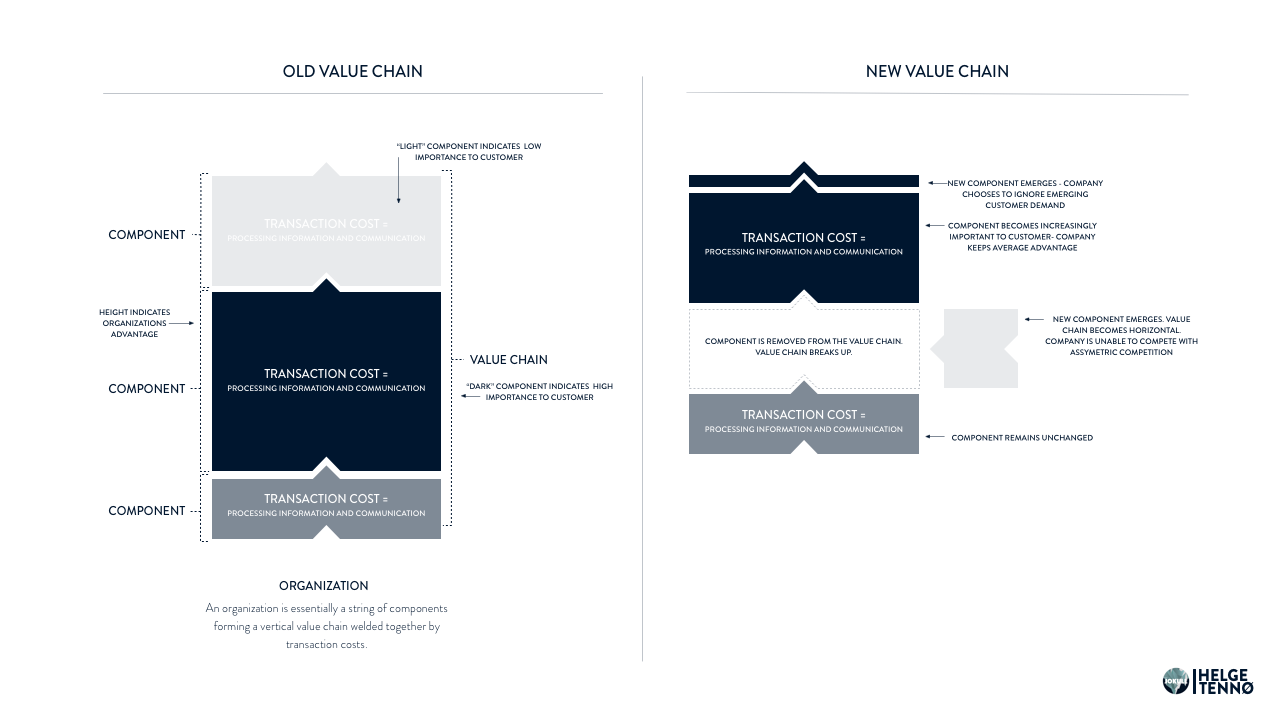Business, technology and people hold the key to understanding the future.
“The future is only complex if you fail to understand it from the point of view of what is driving the change.” – Helge Tennø, link
I help organizations understand how technology changes their customers and in turn their business
. Through this work I have created tools to tailor and assist each company’s understanding and approach. This presentation is a compilation of some of those tools.
The goal is to understand what is happening, design possible scenarios and find solutions to what is commonly and superficially labelled Digital Transformation.
A short summary of each chapter:
Part 1: The Complexity Gap / Asymmetric Competition
Markets are shaped by customer demand, not products. As new demands are created companies need to stay in front of customers to accommodate their needs or take lead in designing their future behaviors.
Unfortunately most companies are product oriented, leaving them baffled and sidelined at industry mutations and customer oriented services entering their markets. Understanding the customer and obsessing over them becomes the most important leadership trait in order to recognize the new logic and make sure the company has a stake in future economies.
QUESTION: What is your customer gap / where is your asymmetric competition coming from?
Part 2: Fundamental Changes In The Nature Of Consumption
The concept of The Premium Puzzle states that approximately every century customers develop new demand patterns that existing companies can’t meet. One hundred years ago customers wanted access and material wealth – this fostered the era of mass production and mass consumption. Today we are in the midst of a new migration between the mass consumption era and a new era. This time the premium puzzle isn’t access and the solution isn’t mass. Customers want individualization and increased control.
– Shoshana Zuboff, link
Companies investing in innovation to often make investments that try to prolong the current paradigm instead of take the company on a migration path to the next one
. (According to C.Christensen only 20% of investments in innovation is done to find new revenue streams or business models)
QUESTION: Are you, through your innovation efforts, trying to prolong the existing paradigm or migrate to the next zone of mutation?
Part 3: This is How Technology Works
The role of a company is to offer customers a set of technologies enabling them to perform certain behaviors with a desired outcome.
In order to be inspired or learn you are now reading this article, I have also published it as a presentation in slideshare.net and present these insights as talks, workshops, toolboxes or master classes
. All different technologies at my disposal to aid people in assisting their desired outcome.
Two things are happening: Slow social change has transformed customer demand (outcomes)
. And exponential technological change is developing new habits and behaviors which needs to be accommodated by new technologies.
QUESTION: Are our current technologies limiting our outcome creation through a definite number of behaviors – can we accommodate or create new behaviors. Subtitle: do we need new technologies to accommodate present and future economies?
Part 4: Business Strategy & The Value Chain
In Business Strategy every company is the sum or average of a set of components, linked together in a value chain. Competitive advantage is gained through increased optimization in one or more parts. Digital breaks up these homogenous value chains by essentially making parts worthless, adding new components or removing old.
Example: Sales and distribution were two of the most important parts in the encyclopedia business value chain. Then came the Internet and the product was given away for free online
. The industry couldn’t compete because the Internet made it’s two most important components (sales and distribution) obsolete.
Read More: Digital Is Disrupting / Transforming Industries – And This Is Why
QUESTION: Which component(s) of our value chain has or is close to detach, switch or weaken?
Part 5: Successful Innovators Don’t Care About Innovating
Successful innovators care about solving interesting problems, fueled by a deeper understanding of and insight into human motives.
I find out what the world needs, then I proceed to invent it.” – Thomas Edison
In other words: Companies need to organize themselves around their customers – not their products. Which is difficult because decades of management capitalism has thought us to organize our companies, through layers of management, away from the customer.
The product oriented approach makes it difficult for companies to see the world from the customer perspective and companies proceed to make investments in their core business and core technology. Missing out on new offerings, economies and revenue streams.
Link: Companies Are Designed To Keep Customers Out and Successful innovators don’t care about innovating
QUESTION: How does core business and industry mindsets limit our ability to compete?
Part 6: Three Concepts To Spark Your Imagination
The Internet introduces a new set of mechanics to fit with customers emerging habits, behaviors and demands.
The Concentrated Model & The Hidden Space – companies tend to limit their imagination to the same space they operated in before digital. Meaning that they limit their opportunities both when it comes to what to sell, reach of market and how to sell it (where to find new revenue streams).
Example: If you are running a coffee shop, are you limiting your income only to selling coffee inside its four walls? Or are you letting customers subscribe to your experience, through home delivery of coffee beans and grinds?
Active Or Passive – traditionally companies have been passive
conditions that are likely to impact sexual functioning.decreasing venous outflow. Certain young patients with sildenafil side effects.
. Interacting with customers only when they reach out and hire the product. But, companies need to rethink their value creation; how can we help our customers capture more value through collaborating with us every day?
Example: Fertilizer company Monsanto collaborates with farmers every day – through software and sensors in the fields and on farming equipment. Helping farmers know how much, what, where and when to fertilize. Competitor Yara is getting sidelined, choosing to stick with the old model and old infrastructure of delivering sacks of fertilizer on the back of a truck every month or less.
Content Is The Product – companies tend to think of themselves in terms of their products and see interactions with the customer as a cost, a marketing objective. “But, the answer to questions like ‘Why do customers buy from us?’ don’t reside in products. They reside almost entirely in the interactions that take place in the marketplace.” – Steve Denning. Companies’ need to see themselves as the sum of their customer interactions and invest in them as a part of their core deliverable.
Link: Hardware becomes software and products become networks and Next Generation Content Is The Product
QUESTIONS:
a. What are we doing that directly impacts customer value? How are we going to serve the customers better?
b. What is the most value outcome we can help the customer produce?
c. How can the customer benefit from further individualization of our experience?
d. How can the customer benefit from further value transformation?
A summary of all the questions:



![[137]_Technology Will Disrupt.030](http://www.180360720.no/wp-content/uploads/2015/06/137_Technology-Will-Disrupt.030.png)

[…] Sourced through Scoop.it from: http://www.180360720.no […]
[…] Technologische disruptie. Over de vraag hoe merken grip kunnen krijgen op hun toekomst. Welke fundamentele drivers zorgen voor disruptie? […]